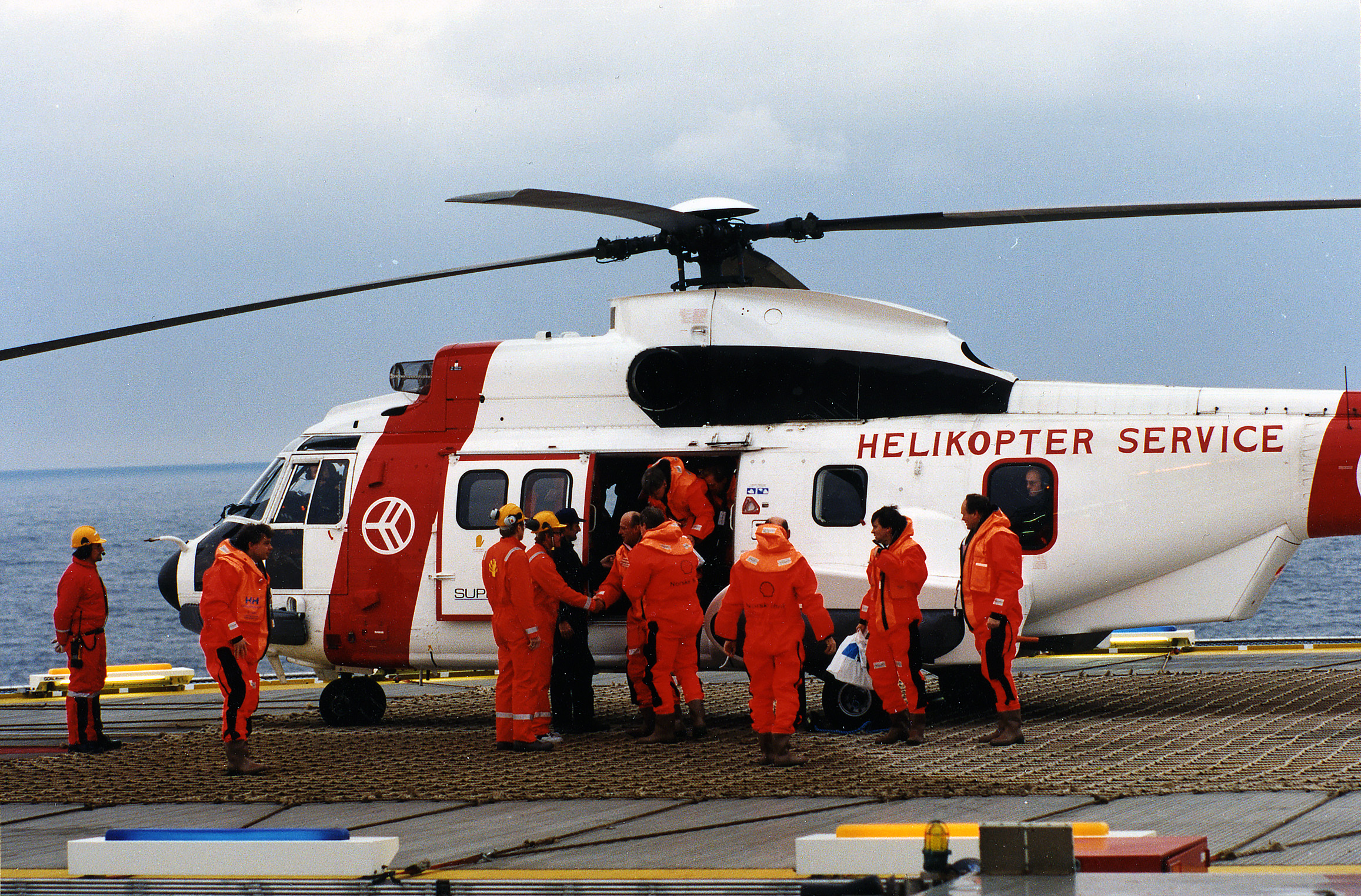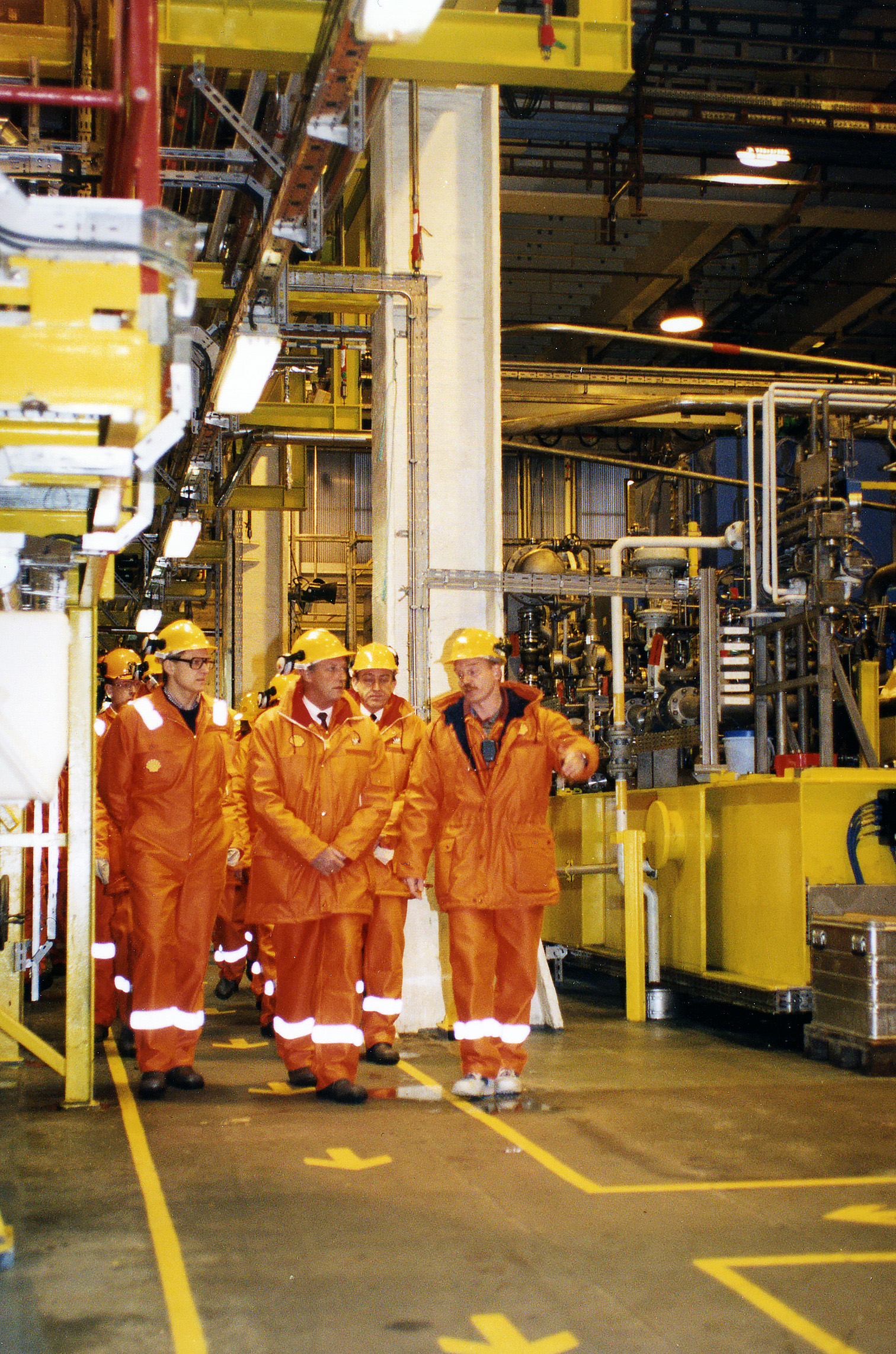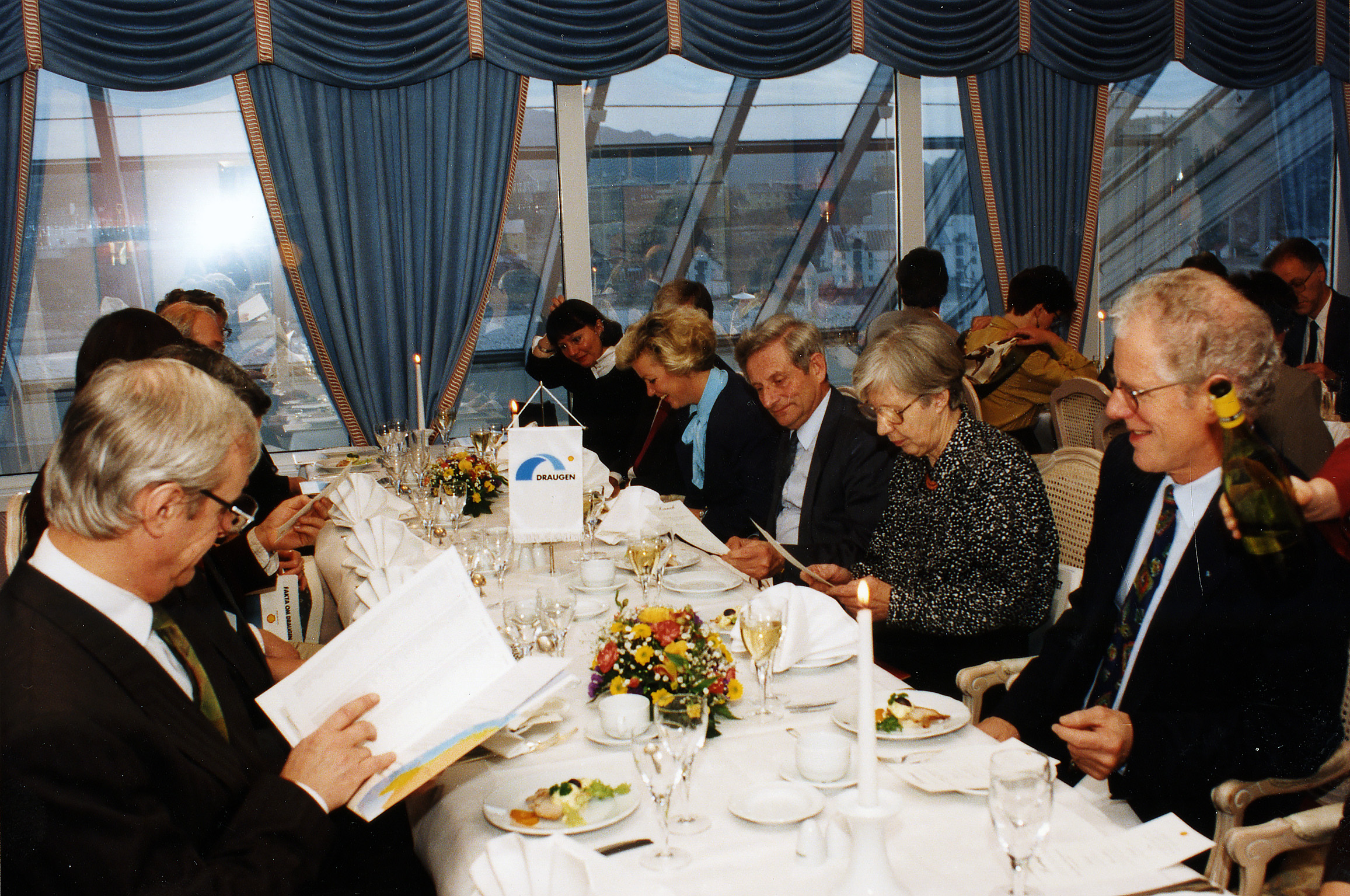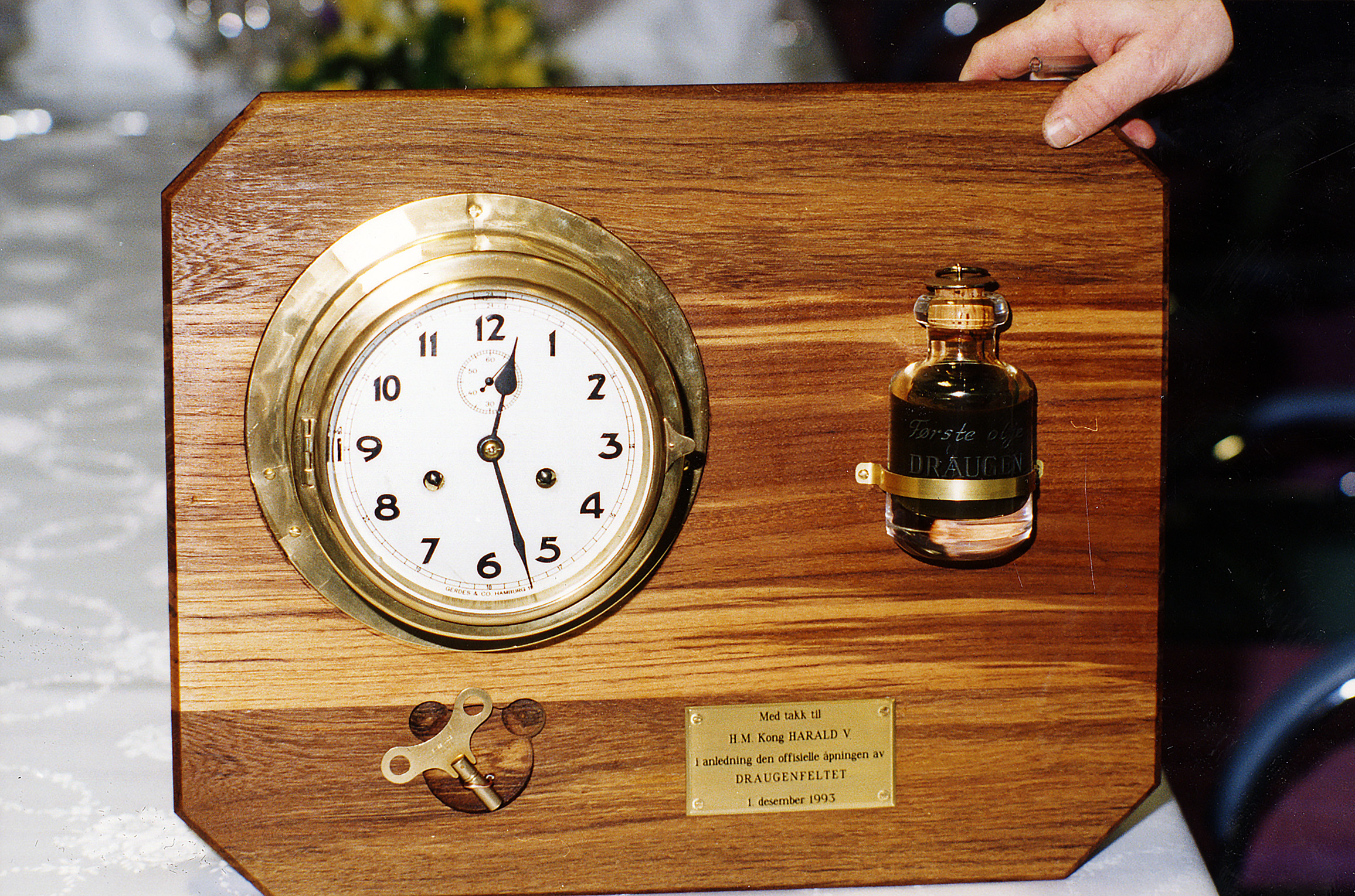Royal opening

This ceremonial act marked the start to oil production not only from a new offshore development but also from a whole new petroleum province on the Norwegian continental shelf (NCS). Tidens Krav, the local Kristiansund newspaper, even saw the ceremony as the beginning of a completely new era for Norway’s oil industry.
It observed that the magic barrier of the 62nd parallel – defined as the northern boundary of the North Sea ¬– had finally been breached. A further petroleum region with unimaginable resources would contribute big assets to the development of Norwegian society for generations to come.
“With the opening of Draugen, the first step has been taken into a new future for mid-Norway [which includes Møre og Romsdal and the Trøndelag region],” the paper wrote.[REMOVE]Fotnote: Asbjørn Jordahl, 2 December 1993. “Mulighetenes ti-år”. Tidens Krav.
 kongen åpner, helikopter, ankomst, engelsk,
kongen åpner, helikopter, ankomst, engelsk,This was also the first field which King Harald had the honour to open, in the presence of 40 carefully selected guests – including Norske Shell CEO Martin van den Wittenboer.
Also invited were Hans Meijer, Norske Shell’s exploration and production head, and the Draugen management team headed by operations manager Terje Olsen.
Møre og Romsdal was represented by county governor Alv Jakob Fostervoll and county council chair Grethe Bjørlo, Kristiansund by mayor Harald Stokke and the Ministry of Industry and Energy by state secretary (junior minister) Gunnar Myrvoll.
A visit by the monarch himself was naturally a big affair. One of his adjutants boarded the platform a week in advance to map out the royal itinerary. Everything was planned in detail – which toilet the king would use, a cabin in case he needed to rest and where he could smoke. Nothing was left to chance. Planning is one thing, reality another. A slight panic arose when the king’s luggage went missing. He had taken off his jacket before donning a survival suit for the flight to the field.
Although the royal guest left the helicopter on Draugen, his luggage with jacket ended up on Regalia, the flotel moored alongside the Draugen platform. “Has anyone seen my jacket,” King Harald enquired after his arrival. A search was instituted, the mishap quickly discovered and the garment returned at express speed.
 kongen åpner, omvisning, engelsk,
kongen åpner, omvisning, engelsk,The tour of the platform and the symbolic opening went entirely according to plan, and the monarch was in high good humour when he pressed the button. In reality, the field had come on stream as early as 19 October and production had therefore been under way for almost six weeks before the royal visit.
The ceremony was followed by lunch in the mess. “Everyone was dressed to the nines and the mood was good,” recalls production head Per Sælevik. “After the main course, though, the king produced a cigarette packet, pulled one out and lit up …”
Operations manager John Aitkin rushed to call the control room. “You must override all the smoke detectors in the canteen,” he ordered. “The king is smoking …” Others took advantage of the royal lead, and the cigarette smoke hung thickly over the mess. “I think I’ve helped a lot of people now,” King Harald observed calmly.[REMOVE]Fotnote: Sælevik, Per, Anecdotes from Draugen, unpublished.
 kongen åpner, lunsj, engelsk,
kongen åpner, lunsj, engelsk,In order for more people to participate in this special day, some 200 guests had been invited to follow the visit via TV monitors at Kristiansund’s Rica Hotel. They toasted and clapped as the button was pressed. The whole event on Draugen was transmitted live, preceded by glimpses from the construction of the concrete gravity base structure, the tow north from Stavanger to the Halten Bank and installation of the platform on 17 May.
Employees in Norske Shell’s operations office at Råket in Kristiansund, its head office in Oslo, and the offices in Sola outside Stavanger and Bergen also saw the transmission.
 kongen åpner, engelsk,
kongen åpner, engelsk,After the king and his entourage had returned from Draugen, a gala dinner was held at the Festiviteten banqueting hall in Kristiansund, with festive speeches and fine words. “The development of Draugen and Heidrun has created optimism and drive in a region which has lagged behind in recent decades,” King Harald observed in his speech.
 kongen åpner, skipsklokke,
kongen åpner, skipsklokke,He concluded by hoping that the town and its environs would meet the new challenges with hope, enthusiasm and a willingness to commit. After various cultural interludes, the monarch was presented by Mahdi Hasan, project director for the Draugen development, with a gift from Norske Shell. This took the form of an exact copy of the ship’s bell from the old royal yacht Heimdal, which had greeted the king’s grandfather, King Haakon VII, off Drøbak on the Oslo Fjord.
Accompanied by Queen Maud and Crown Prince Olav, Norway’s new monarch had been on his way to the capital on 25 November 1905 to take up his throne.
Kristiansund council did not want to be put in the shade, and Stokke presented King Harald with cufflinks bearing the town’s coat of arms.
 kongen åpner, skipsklokke, engelsk,
kongen åpner, skipsklokke, engelsk,He followed up by girting the Draugen administration with the six-volume history of the town. The new residents were to be incorporated not only in its present and future but also its past.
Fog and wind prevented the return flight to Oslo taking off from Kvernberget, and the king’s departure was therefore postponed. Instead, the party continued with more drinks being served and the mood rose irreproachably. The weather improved late in the evening and the royal plane could take off.
On the following day, Draugen information manager Alf Kristian Lillebo was called by the county governor and feared that something had gone wrong. But the governor wanted to report that the palace had called to express its satisfaction with the arrangements. Queen Sonja had commented that His Majesty had been in an unusually good mood when he returned the evening before.[REMOVE]Fotnote: Sælevik, Per, Anecdotes from Draugen, unpublished.
Film: Draugen opening ceremony
Photo: Draugen opening ceremony
Began with a leakNew shutdown